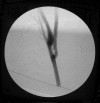Cerebral revascularization in skull base tumors
- PMID: 16148985
- PMCID: PMC1151705
- DOI: 10.1055/s-2005-868164
Cerebral revascularization in skull base tumors
Abstract
Skull base tumors involving the carotid artery pose a difficult surgical challenge. The potential for bypass grafting for cerebral revascularization carries inherent risks but may aid in tumor resection and control in those who warrant carotid sacrifice but have inappropriate natural cerebrovascular reserve. We include a review of the literature discussing the indications for carotid resection as part of skull base tumor surgery, indications for cerebral revascularization, balloon test occlusion, graft types and operative technique, complications, and results.
Figures













References
-
- Lougheed W, Marshall B, Hunter M, et al. Common carotid to internal carotid bypass venous graft. Technical note. J Neurosurg. 1971;34:114–118. - PubMed
-
- Fisch U P, Olding D J, Senning A. Surgical therapy of internal carotid artery lesions of the skull base and temporal bone. Otolaryngol Head Neck Surg. 1980;88:548–554. - PubMed
-
- Glassock M, Smith P, Bond A, Whitaker S, Bartels L. Management of aneurysms of the petrous portion of the internal carotid artery by resection and primary anastomosis. Laryngoscope. 1983;93:1445–1453. - PubMed
-
- Sekhar L, Sen C, Jho H. Saphenous vein graft bypass of the cavernous internal carotid artery. J Neurosurg. 1990;72:35–41. - PubMed

